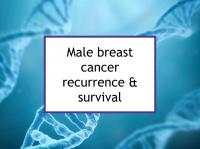Below we summarize available data published since 2020 concerning the risk of recurrence for invasive male breast cancer. However, please note that outcomes can vary greatly depending on numerous factors and the statistics below represent snapshots from studies that were conducted under a variety of circumstances.
Therefore, the numbers are somewhat inconsistent and far from definitive and should not be used to calculate your likely recurrence-free survival. However, the data is useful in getting a general idea of male breast cancer prognosis and to compare outcomes depending on treatment and other factors. For example, the data suggests that breast conserving surgery (lumpectomy) typically has a better prognosis when followed by radiotherapy, especially for stage II and stage III disease.
Definition of survival terms
Progression-free survival means that no recurrence, metastasis or breast cancer-related death took place during the specified period. Overall survival means no death occurred (whether from breast cancer or from another cause).
Male breast cancer recurrence & survival data
Patient and treatment characteristics → Likelihood of progression-free or overall survival
General survival - U.S. male breast cancer population
- Overall survival
- Five-year overall survival → 63% to 92%
- Five-year progression-free survival → 76% to 86%
- Overall survival by ethnicity
- Five-year overall survival, African American → 67% to 78%
- Five-year overall survival, Latino → 81% to 87%
- Five-year overall survival, Asian or Pacific Islander → 81% to 88%
- Five-year overall survival, Non-Hispanic white → 77% to 86%
Survival based on stage at diagnosis
- Five-year overall survival by stage
- Stage I: Five-year overall survival → 82% to 99%
- Stage II: Five-year overall survival → 65% to 86%
- Stage III: Five-year overall survival → 43% to 78%
- Stage IV: Five-year overall survival → 14% to 37%
- Five-year survival for stage I-III
- Stage I-III: Five-year overall survival → 83%
- Stage I-III: Five-year progression-free survival → 66%
- 20-year breast cancer-specific survival for ER+/PR+
- Stage I: ER+/PR+ 20-year breast cancer-specific survival → 88%
- Stage II: ER+/PR+ 20-year breast cancer-specific survival → 74%
- Stage III: ER+/PR+ 20-year breast cancer-specific survival → 54%
Survival based on receptor type
- Hormone receptor positive (ER+/PR+)
- ER+/PR+/HER2-: Five-year overall survival → 66% to 77%
- ER+/PR+/HER2+: Five-year overall survival → 65%
- Hormone receptor negative (ER-/PR-)
- ER-/PR-/HER2+: Five-year overall survival → 84%
- ER-/PR-/HER2-: Five-year overall survival → 48%
Survival based on treatment
- Survival based on use of chemotherapy
- Chemotherapy: Four-year overall survival → 98%
- No chemotherapy: Four-year overall survival → 95%
- Survival based on use of tamoxifen
- Tamoxifen: Median 39-month progression-free survival → 89%
- No tamoxifen: Median 39-month progression-free survival → 82%
- Survival based on use of endocrine treatment (tamoxifen or aromatase inhibitor)
- Endocrine treatment: Five-year overall survival → 74%
- No endocrine treatment: Five-year overall survival → 37%
- Survival based on lumpectomy plus radiotherapy
- Stage I radiotherapy: Five-year overall survival → 77%
- Stage I no radiotherapy: Five-year overall survival → 63%
- Stage I radiotherapy, age ≥ 65: 15-year overall survival → 32%
- Stage I no radiotherapy, age ≥ 65: 15-year overall survival → 34%
- Stage II radiotherapy: Five-year overall survival → 72%
- Stage II no radiotherapy: Five-year overall survival → 40%
- Stage III radiotherapy: Five-year overall survival → 68%
- Stage III no radiotherapy: Five-year overall survival → 35%
- Survival based on mastectomy plus radiotherapy
- Stage I radiotherapy: Five-year overall survival → 65%
- Stage I no radiotherapy: Five-year overall survival → 68%
- Stage II radiotherapy: Five-year overall survival → 58%
- Stage II no radiotherapy: Five-year overall survival → 53%
- Stage III radiotherapy: Five-year overall survival → 42%
- Stage III no radiotherapy: Five-year overall survival → 28%
Below are links to recent studies concerning this topic. Please also see our article on male breast cancer, which describes factors that drive outcomes in male breast cancer.
